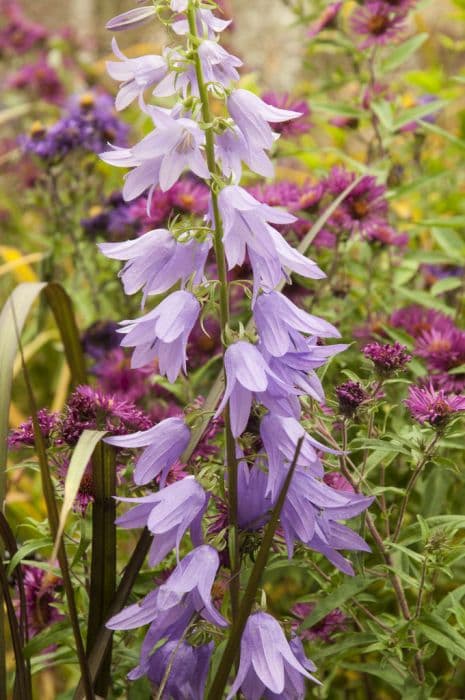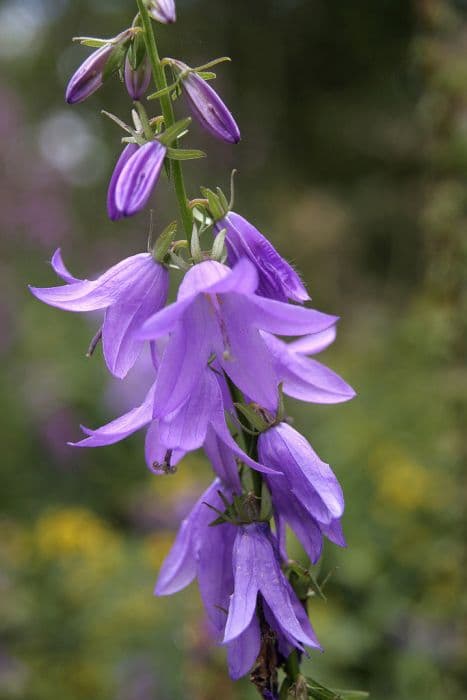Nettle-leaved bellflower Campanula trachelium

ABOUT
The plant known as nettle-leaved bellflower possesses a distinctive and charming presence among garden flora. It is characterized by its beautiful bell-shaped flowers, which exhibit a soothing blue to violet shade, often enchanting to onlookers. These blooms are neatly arranged on an upright flowering stalk, making them quite eye-catching. The flower's corolla is fused and opens into a flared shape, with the petals slightly reflexed at the tips, accentuating the bell-like form that is so iconic to this species. The foliage of the nettle-leaved bellflower adds to its visual interest. True to its common name, the leaves are reminiscent of those from a nettle, with their texture and serrated edges. The leaves create a lush backdrop for the vibrant blooms, with their deep green coloration and coarse texture, which contrast nicely against the smoothness of the petals. Together with its elegant flowers and nuanced leaf structure, the nettle-leaved bellflower brings a wild, yet graceful, addition to any garden setting, attracting pollinators and admirers alike with its charming features. The overall impression of this plant is one of rustic beauty, offering a touch of the English countryside to wherever it grows.
About this plant
 Names
NamesFamily
Campanulaceae.
Synonyms
Nettle-leaved Bellflower, Bats-in-the-belfry, Throatwort.
Common names
Campanula urticifolia, Campanula trachelium var. alba.
 Toxicity
ToxicityTo humans
Bellflower (Campanula trachelium) does not have a well-documented toxicity profile for humans. It is not generally considered a poisonous plant, and there is limited information on its potential adverse effects if ingested. However, like with any plant material, individual allergic reactions or sensitivities are possible. If symptoms do occur after ingestion, they might resemble those of plant allergies or mild gastrointestinal upset. It's always a good practice to err on the side of caution and not consume plants not known to be safe for human consumption.
To pets
Bellflower (Campanula trachelium) is not commonly listed as a toxic plant to pets such as dogs and cats. There is a lack of specific information regarding the plant's toxicity to animals. That being said, individual animals may have unique sensitivities or allergies, and ingestion of plant material can sometimes lead to gastrointestinal distress such as vomiting or diarrhea. If you suspect your pet has ingested this plant and is showing signs of illness, it is best to consult a veterinarian.
 Characteristics
CharacteristicsLife cycle
Biennials
Foliage type
Deciduous
Color of leaves
Green
Flower color
Blue
Height
2-4 feet (0.6-1.2 meters)
Spread
1-2 feet (0.3-0.6 meters)
Plant type
Herb
Hardiness zones
4-8
Native area
Europe
Benefits
 General Benefits
General Benefits- Attracts Pollinators: Campanula trachelium, commonly known as nettle-leaved bellflower, is known to attract bees and other beneficial pollinators to the garden, which can help in the pollination of other plants.
- Garden Aesthetics: With its appealing blue to violet bell-shaped flowers, the nettle-leaved bellflower can enhance the visual appeal of gardens and landscapes.
- Biodiversity: By providing habitat and food for pollinators, Campanula trachelium contributes to increasing biodiversity within its growing environment.
- Low Maintenance: Once established, the nettle-leaved bellflower is relatively low maintenance, requiring minimal care beyond occasional watering and the removal of spent flowers to promote further blooming.
- Erosion Control: The plant can help prevent soil erosion when grown on slopes or in areas prone to erosion due to its root structure.
- Edible Parts: Although this list is to exclude medicinal properties, it's worth noting that some parts of the plant have been traditionally used as food in various cultures.
 Medical Properties
Medical Properties- Anti-inflammatory: Campanula trachelium has been traditionally used for its potential anti-inflammatory properties.
- Soothing agent: It is believed to have a soothing effect when applied to skin irritations and inflammations.
- Antiseptic: The plant may possess mild antiseptic qualities which could be beneficial in cleaning minor wounds.
- Expectorant: Historically, it has been used to alleviate coughs and as an expectorant to help clear mucus from the respiratory tract.
- Throat ailments: It has been used in traditional medicine to treat sore throats and laryngitis due to its purported soothing effect.
 Air-purifying Qualities
Air-purifying QualitiesThis plant is not specifically known for air purifying qualities.
 Other Uses
Other Uses- The leaves of nettle-leaved bellflower can be used as a filler in bouquets and flower arrangements for their lush green appearance and heart-shaped foliage.
- Nettle-leaved bellflower is often cultivated in gardens for its decorative flowers, which enhance the aesthetics of wildflower gardens and traditional cottage gardens.
- The blooms of nettle-leaved bellflower can be pressed and used in botanical art or crafts, preserving their beauty long after they fade.
- Dried flowers of nettle-leaved bellflower can be used in potpourri to add color and a mild fragrance to a room.
- Nettle-leaved bellflower can be planted as part of a butterfly or bee garden to attract and support local pollinators due to its appealing flowers.
- This plant can serve as a ground cover in shaded areas, helping to control soil erosion and suppress weed growth.
- The seeds of nettle-leaved bellflower are a food source for some bird species, promoting biodiversity in the garden.
- Nettle-leaved bellflower may be used in educational settings, such as plant identification and botanical studies, due to its distinct characteristics.
- In folklore, the nettle-leaved bellflower is sometimes associated with gratitude and constancy, making it a meaningful gift in a bouquet.
- Artists and photographers can use the striking flowers of nettle-leaved bellflower as subjects for their works, capturing the plant's natural beauty.
Interesting Facts
 Feng Shui
Feng ShuiThe plant commonly known as Bats-in-the-belfry is not used in Feng Shui practice.
 Zodiac Sign Compitability
Zodiac Sign CompitabilityBats-in-the-belfry is not used in astrology practice.
 Plant Symbolism
Plant Symbolism- Persistence: The Campanula trachelium, commonly known as Bats-in-the-belfry, is a resilient plant that can thrive in a variety of conditions, representing the ability to persist through challenges.
- Gratitude: Often considered a gift in floral language, Bats-in-the-belfry is symbolic of gratitude and the appreciation of others.
- Constancy: The bell-shaped flowers of this plant can imply steadfastness and unchanging nature, suggesting the concept of constancy in relationships or endeavors.
- Humility: Bats-in-the-belfry, with its modest flowers that hang down, is associated with humility and the idea of grace without the need for ostentation.
 Water
WaterThe Canterbury Bells should be watered deeply once a week, ensuring the soil is moist but not waterlogged. During the active growing season, the amount of water typically needed is about 1 to 1.5 gallons for an outdoor plant, depending on the weather conditions such as heat and wind that could dry out the soil faster. Watering should be done at the base of the plant to avoid wetting the foliage, which can lead to fungal diseases. In the dormant period, reduce watering to every two weeks, but do not allow the soil to completely dry out.
 Light
LightCanterbury Bells thrives best in full sun to partial shade conditions. The ideal spot for these plants is a location where they can receive at least 6 hours of sunlight daily, but are also protected from the intense afternoon sun in hot climates.
 Temperature
TemperatureCanterbury Bells prefer moderate temperatures and can generally handle minimum temperatures down to 20°F, while maximum temperatures should not exceed 85°F for optimal growth. The ideal temperature range for Canterbury Bells is between 60°F and 75°F, making them suitable for temperate climates.
 Pruning
PruningPrune Canterbury Bells to remove dead or faded flowers, which encourages more blooms and prevents the plant from self-seeding too prolifically. The best time to prune is after the main flowering period, typically in late summer. Deadheading can be done throughout the blooming season to maintain plant vigor and appearance.
 Cleaning
CleaningAs needed
 Soil
SoilThe Nettle-leaved Bellflower thrives best in well-draining, loamy soil with a pH slightly alkaline to neutral, ranging between 7.0 and 7.5. An ideal soil mixture can be created by combining garden soil, compost, and a small amount of sand or perlite to improve drainage.
 Repotting
RepottingNettle-leaved Bellflower should be repotted every 2-3 years to replenish nutrients in the soil and to accommodate the growth of the plant. Repotting is best done in the spring or early summer when the plant is actively growing.
 Humidity & Misting
Humidity & MistingNettle-leaved Bellflower prefers moderate humidity levels but is quite adaptable and can tolerate the average humidity found in most homes. It does not have specific high humidity requirements.
 Suitable locations
Suitable locationsIndoor
For indoor Nettle-leaved Bellflower, ensure bright, indirect light and regular watering.
Outdoor
Plant Nettle-leaved Bellflower in sun/partial shade and moist, well-draining soil.
Hardiness zone
4-8 USDA
 Life cycle
Life cycleCampanula trachelium, commonly known as the nettle-leaved bellflower, begins its life cycle as a seed, typically germinating in spring when temperatures and moisture levels are suitable. The seedlings develop into rosettes of basal leaves during their first year, a period of vegetative growth where they store energy for future blooming. In the following year or years, the plant enters its reproductive phase, sending up flowering stems that bear the characteristic bell-shaped blue or violet flowers between June and September. After pollination, often by bees attracted to the flowers' nectar, the plant produces capsules containing numerous small seeds. These seeds are dispersed by wind or other means, allowing the nettle-leaved bellflower to colonize new areas. The plant is a perennial, so after setting seed, the above-ground parts die back, but the root system remains alive and dormant until the next spring, when the cycle begins anew.
 Propogation
PropogationPropogation time
Spring to Summer
Propogation: Campanula trachelium, commonly known as nettle-leaved bellflower, is typically propagated by seed. The most popular method of propagation for this plant involves sowing seeds either in fall or early spring directly into the garden where they will grow. To ensure a good start, the soil should be well-drained and amended with compost to provide nutrients. After sprinkling the seeds lightly over the soil, they should be barely covered with a thin layer of soil or compost. Seeds need ample sunlight to germinate, so the location should receive full sun to part shade. Water the seedbed gently but ensure it stays consistently moist until germination, which can take anywhere from two to four weeks. Once seedlings have developed a couple of sets of true leaves, they can be thinned out to prevent overcrowding and promote healthy growth.









